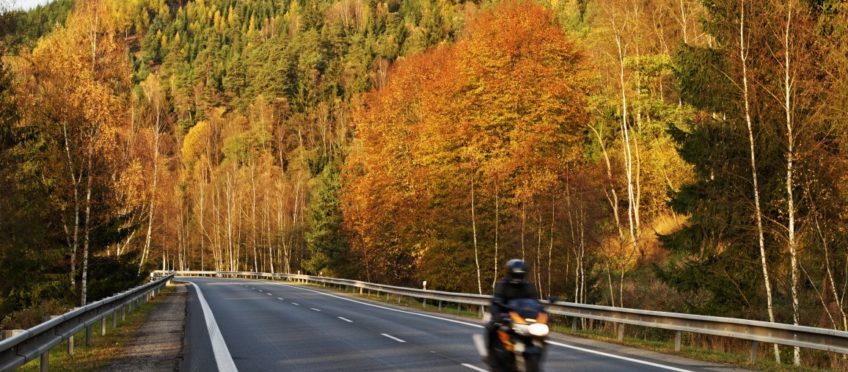September is the highlight of the season for many riders. It’s generally sunny and dry, with pleasant temperatures. Vacation traffic has thinned, leaving more open road for enjoyable all-day cruising.
The inevitable cycles of nature, however, signal the season is winding down and bring in unique hazards for motorcyclists. Here’s what to watch for at this time of year keep safe.
10 Autumn Hazards And How To Handle Them
Wildlife. OPP report approximately 10,000 drivers strike wild animals each year. Eighty-nine percent occur on two-lane rural roads and most of the hits are deer. They’re migrating and mating, on the move with unpredictable behavior. Peak months are October to January, with November the most dangerous. Ride cautiously, especially between dusk and dawn, paying extra heed at posted jumping deer signs. Watch roadsides for movement and tell-tale eye-glare at night. Read more about “OH, DEER! AVOIDING WILDLIFE ON THE HIGHWAY”.
Fallen leaves. Dry leaves camouflage loose gravel, potholes, and other objects. Wet leaves are slippery, creating hazards on corners and curves. Even condensation can dampen them enough to make them treacherous. Keep a special watch in shaded areas where sunlight can’t get at leaves to dry them.
Reduced daylight. Darkness descends earlier every day and sticks around later in the morning. If you enjoy evening rides, be prepared to ride in the dark. Make sure bulbs in headlights, turn signals, and brake lights are working and not occluded. Wear reflective gear to maximize your chances of being seen by other traffic.
Sunlight glare. The northern hemisphere tilts away from the sun in autumn and winter, making it sit lower in the sky. The glare can be distracting, even with quality UV shades. As trees shed their leaves, sunshine filtering through the branches creates mottled patterns on the road and a strobe effect as you’re riding through wooded areas. Reduce your speed and increase the frequency of breaks to give your eyes a chance to recover.
Tires. Tires take longer to heat up and cool down faster as the mercury dips. That means less traction and reduced performance. Generally, the softer the rubber compound, like that in tires typically found on sport bikes, the more their stickiness is reduced. Touring tires can be ridden further into the season with greater confidence. Slow down, brake earlier, and activate levers smoothly.
Cold temperatures also cause air pressure to drop, making you lose a few PSI. Monitor your tire pressure more frequently, especially if you’re carrying a passenger.
Road surfaces. Frost can create a thin film of ice on pavement. Be alert to falling temperatures, especially in shaded areas, low-lying landforms, and on bridges. Anticipate thermal fluctuations if you’re changing elevations. Use the outdoor temperature indicator on your bike as a guide only. The temperature it’s registering may be different from that at the road surface.
Other drivers. They don’t notice us at peak riding times when motorcycles are expected to be out on the road, let alone when the weather turns and fewer riders are out. Make yourself as visible as possible, ride with confidence, and maintain your vigilance, anticipating unpredictable moves. Keep defensive manoeuvres sharp by practicing regularly throughout the season.
Bulky gear. Prepare for the day’s ride by dressing in layers or carry additional pieces you can add as necessary. Bulk is uncomfortable, distracting, fatiguing, and can make it harder to react to sudden events. Thermal base layers, like merino, are thin yet still effective at insulating you from the cold. Consider adding good quality heated gear to your wardrobe.
Hypothermia. Your body isn’t generating much heat when you’re riding so it’s easy to get chilled. Add in the effect of cold air rushing against you, medical conditions, and individual responses and your internal temperature can drop. Stay warm by wearing insulating layers to reduce the rate of heat loss, and windproof clothing to prevent the wind from stealing what heat you have. Even when heated gear keeps you warm and dry, cold ambient temperatures can cool you. Make extra efforts to stay hydrated, even though it means more frequent pit stops with hassle because of extra layers. Take extra breaks to avoid fatigue.
Seasonal businesses. Fall colours rides are highly anticipated and draw us into cottage country. Keep in mind that seasonal businesses may be closed and services less accessible. Plan accordingly for gas, food, lodging, and emergency contacts.
Autumn is a beautiful time to ride. There is less traffic on back roads, the fall colors are spectacular, and the air is clear and crisp. Once the leaves have fallen, the underlying rocks and terrain become visible, offering a fresh perspective on what may be familiar landscape.
The hazards aren’t necessarily greater than during other seasons – only different. Awareness, vigilance, and preparedness go a long way in extending your season safely and enjoyably.







join the conversation